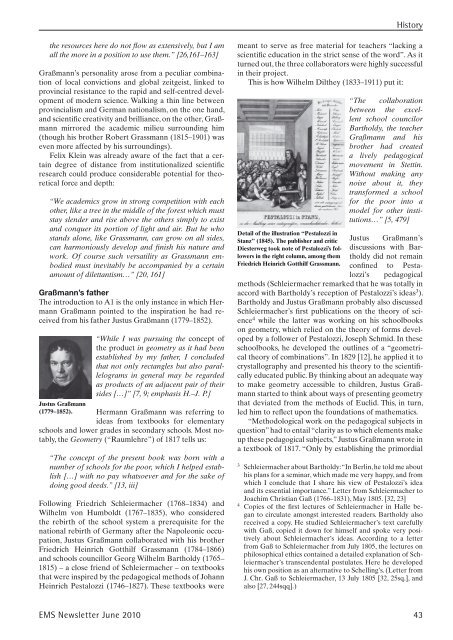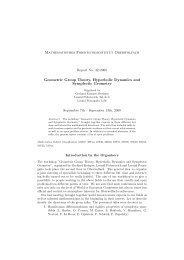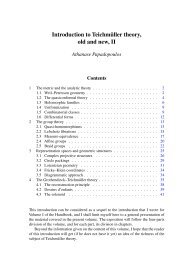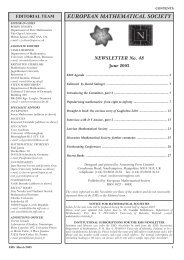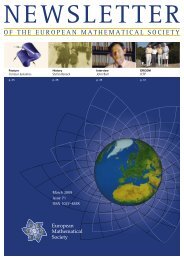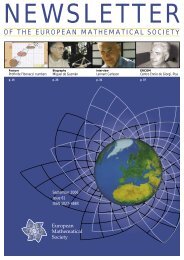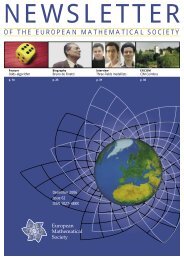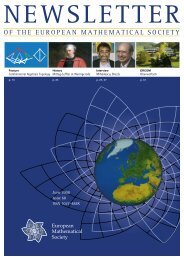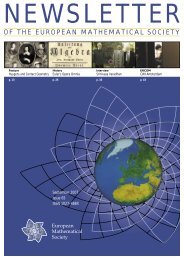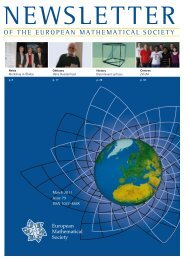EMS Newsletter June 2010 - European Mathematical Society ...
EMS Newsletter June 2010 - European Mathematical Society ...
EMS Newsletter June 2010 - European Mathematical Society ...
Create successful ePaper yourself
Turn your PDF publications into a flip-book with our unique Google optimized e-Paper software.
the resources here do not flow as extensively, but I am<br />
all the more in a position to use them.” [26,161–163]<br />
Graßmann’s personality arose from a peculiar combination<br />
of local convictions and global zeitgeist, linked to<br />
provincial resistance to the rapid and self-centred development<br />
of modern science. Walking a thin line between<br />
provincialism and German nationalism, on the one hand,<br />
and scientific creativity and brilliance, on the other, Graßmann<br />
mirrored the academic milieu surrounding him<br />
(though his brother Robert Grassmann (1815–1901) was<br />
even more affected by his surroundings).<br />
Felix Klein was already aware of the fact that a certain<br />
degree of distance from institutionalized scientific<br />
research could produce considerable potential for theoretical<br />
force and depth:<br />
“We academics grow in strong competition with each<br />
other, like a tree in the middle of the forest which must<br />
stay slender and rise above the others simply to exist<br />
and conquer its portion of light and air. But he who<br />
stands alone, like Grassmann, can grow on all sides,<br />
can harmoniously develop and finish his nature and<br />
work. Of course such versatility as Grassmann embodied<br />
must inevitably be accompanied by a certain<br />
amount of dilettantism…” [20, 161]<br />
Graßmann’s father<br />
The introduction to A1 is the only instance in which Hermann<br />
Graßmann pointed to the inspiration he had received<br />
from his father Justus Graßmann (1779–1852).<br />
Justus Graßmann<br />
(1779–1852).<br />
“While I was pursuing the concept of<br />
the product in geometry as it had been<br />
established by my father, I concluded<br />
that not only rectangles but also parallelograms<br />
in general may be regarded<br />
as products of an adjacent pair of their<br />
sides […]” [7, 9; emphasis H.–J. P.]<br />
Hermann Graßmann was referring to<br />
ideas from textbooks for elementary<br />
schools and lower grades in secondary schools. Most notably,<br />
the Geometry (“Raumlehre”) of 1817 tells us:<br />
“The concept of the present book was born with a<br />
number of schools for the poor, which I helped establish<br />
[…] with no pay whatsoever and for the sake of<br />
doing good deeds.” [13, iii]<br />
Following Friedrich Schleiermacher (1768–1834) and<br />
Wilhelm von Humboldt (1767–1835), who considered<br />
the rebirth of the school system a prerequisite for the<br />
national rebirth of Germany after the Napoleonic occupation,<br />
Justus Graßmann collaborated with his brother<br />
Friedrich Heinrich Gotthilf Grassmann (1784–1866)<br />
and schools councillor Georg Wilhelm Bartholdy (1765–<br />
1815) – a close friend of Schleiermacher – on textbooks<br />
that were inspired by the pedagogical methods of Johann<br />
Heinrich Pestalozzi (1746–1827). These textbooks were<br />
History<br />
meant to serve as free material for teachers “lacking a<br />
scientific education in the strict sense of the word”. As it<br />
turned out, the three collaborators were highly successful<br />
in their project.<br />
This is how Wilhelm Dilthey (1833–1911) put it:<br />
Detail of the illustration “Pestalozzi in<br />
Stanz” (1845). The publisher and critic<br />
Diesterweg took note of Pestalozzi’s followers<br />
in the right column, among them<br />
Friedrich Heinrich Gotthilf Grassmann.<br />
“The collaboration<br />
between the excellent<br />
school councilor<br />
Bartholdy, the teacher<br />
Graßmann and his<br />
brother had created<br />
a lively pedagogical<br />
movement in Stettin.<br />
Without making any<br />
noise about it, they<br />
transformed a school<br />
for the poor into a<br />
model for other institutions…”<br />
[5, 479]<br />
Justus Graßmann’s<br />
discussions with Bartholdy<br />
did not remain<br />
confined to Pestalozzi’s<br />
pedagogical<br />
methods (Schleiermacher remarked that he was totally in<br />
accord with Bartholdy’s reception of Pestalozzi’s ideas 3 ).<br />
Bartholdy and Justus Graßmann probably also discussed<br />
Schleiermacher’s first publications on the theory of science<br />
4 while the latter was working on his schoolbooks<br />
on geometry, which relied on the theory of forms developed<br />
by a follower of Pestalozzi, Joseph Schmid. In these<br />
schoolbooks, he developed the outlines of a “geometrical<br />
theory of combinations”. In 1829 [12], he applied it to<br />
crystallography and presented his theory to the scientifically<br />
educated public. By thinking about an adequate way<br />
to make geometry accessible to children, Justus Graßmann<br />
started to think about ways of presenting geometry<br />
that deviated from the methods of Euclid. This, in turn,<br />
led him to reflect upon the foundations of mathematics.<br />
“Methodological work on the pedagogical subjects in<br />
question” had to entail “clarity as to which elements make<br />
up these pedagogical subjects,” Justus Graßmann wrote in<br />
a textbook of 1817. “Only by establishing the primordial<br />
3 Schleiermacher about Bartholdy: “In Berlin, he told me about<br />
his plans for a seminar, which made me very happy, and from<br />
which I conclude that I share his view of Pestalozzi’s idea<br />
and its essential importance.” Letter from Schleiermacher to<br />
Joachim Christian Gaß (1766–1831), May 1805. [32, 23]<br />
4 Copies of the first lectures of Schleiermacher in Halle began<br />
to circulate amongst interested readers. Bartholdy also<br />
received a copy. He studied Schleiermacher’s text carefully<br />
with Gaß, copied it down for himself and spoke very positively<br />
about Schleiermacher’s ideas. According to a letter<br />
from Gaß to Schleiermacher from July 1805, the lectures on<br />
philosophical ethics contained a detailed explanation of Schleiermacher’s<br />
transcendental postulates. Here he developed<br />
his own position as an alternative to Schelling’s. (Letter from<br />
J. Chr. Gaß to Schleiermacher, 13 July 1805 [32, 25sq.], and<br />
also [27, 244sqq].)<br />
<strong>EMS</strong> <strong>Newsletter</strong> <strong>June</strong> <strong>2010</strong> 43


